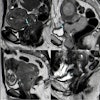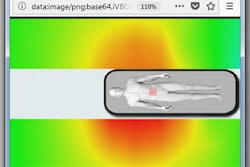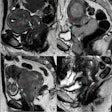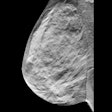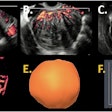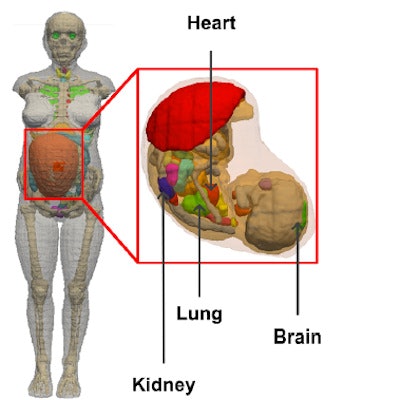
Researchers from Switzerland have developed computer models to estimate the radiation dose to fetuses of pregnant women undergoing CT. The ramifications include better decision-making for doctors and patients, according to the study team.
A research team led by Habib Zaidi, PhD, head of the PET instrumentation and neuroimaging laboratory at the department of Medical Imaging and Information Sciences at Geneva University Hospital, created a computer model of a typical pregnant patient based on previous research. The researchers then estimated the maternal absorbed dose and fetal organ radiation dose for 30 pregnant patients referred for abdominal CT scans at their institution. They determined the fetal dose normalized to the CT dose index volume (CTDIvol) varied between 0.85 mGy and 16.3 mGy.
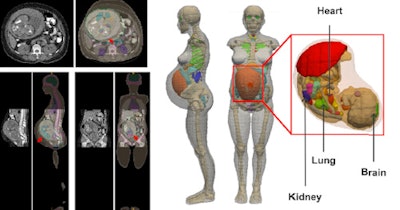 Representative slices showing transverse (top), sagittal (bottom and left), and coronal (bottom and right) views of the developed computational phantoms at 35 weeks gestational age. Images also show registration between abdominal CT images of the patient and the computational phantom for the development of patient-specific pregnant computational models. A zoomed view of the 3D patient-specific pregnant computational model with the embedded fetus also is shown. All images courtesy of Habib Zaidi, PhD.
Representative slices showing transverse (top), sagittal (bottom and left), and coronal (bottom and right) views of the developed computational phantoms at 35 weeks gestational age. Images also show registration between abdominal CT images of the patient and the computational phantom for the development of patient-specific pregnant computational models. A zoomed view of the 3D patient-specific pregnant computational model with the embedded fetus also is shown. All images courtesy of Habib Zaidi, PhD."Because patient size has a noticeable effect on fetal dose estimates, this work shows that patient-specific computational models can be created based on the available standardized computational phantoms of pregnant females to reflect personalized body morphometries," they wrote (European Radiology, 8 September 2017). "This enables radiologists to perform patient-specific dosimetry for a variety of radiation exposure situations and provide elaborate estimation of organ-level radiation dose to the fetus."
Phantom figures
Radiation dose is a concern for all patients but even more so for fetuses. At doses greater than 100 mGy, potentially hazardous effects to the pregnant patient and unborn child include possible spontaneous abortion, intrauterine growth limitation, average IQ loss, mental retardation, possible organ malformation, and small head size, according to the researchers.
However, even lower radiation doses can detrimentally affect the fetus -- for instance, it's known that CT doses above 5 mGy can affect the nervous system. Therefore, clinicians highly desire accurate estimates of fetal absorbed dose, but this presents a challenge because direct measurements of energy deposition in the fetal body cannot be performed in human beings due to ethical and radiation protection issues.
To circumvent the challenge, researchers estimate fetal dose using Monte Carlo simulations with computational anthropomorphic models, and they use measurements of physical phantoms with embedded dosimeters. But with these approaches, it's still difficult to construct patient-specific computational models and match anthropomorphic physical phantoms to the size and location of the fetus within the pregnant patient.
"We have observed over the years that the number of CT and hybrid PET/CT imaging examinations performed worldwide on pregnant patients has increased significantly," Zaidi wrote in an email. "This increase has raised health concerns regarding the radiation risks to the fetus owing to the potential hazard effects of radiation on the fetus. Therefore, we thought that estimation of the fetal absorbed dose from CT examinations is highly desired owing to the high radiosensitivity of developing fetal organs. Current techniques used in clinical departments and implemented on commercial software platforms are not accurate enough owing to a number of inherent limitations in the assumptions behind these calculations. We therefore sought to develop novel techniques enabling more accurate assessment of the radiation dose delivered to the fetus."
In the current study, Zaidi and colleagues constructed patient-specific computational models based on image segmentation and registration methods. They used previously developed standardized hybrid computational phantoms of pregnant women.
They integrated a Discovery CT 750 HD CT scanner (GE Healthcare) with the N-Particle eXtended (MCNPX) Monte Carlo code. The patient-specific maternal and fetal absorbed radiation doses were calculated and compared with the results provided by the Radimetrics (Bayer Healthcare) commercial dose-tracking software. The researchers investigated the correlation among patient anatomy, gestational age fetal position, and fetal organ-level dose using the CT scans.
| Comparison of effective dose and average dose | ||
| Effective dose | Average dose | |
| Xie et al | 1.1-2.0 mSv | 1.6 mSv ± 0.22 |
| Radimetrics | 1.7-2.3 mSv | 1.9 mSv ± 0.14 |
| Dose length product (DLP) | 1.5-1.9 mSv | 1.6 mSv ± 0.11 |
| Fetus brain | -- | 3.11 mGy ± 1.09 |
| Fetus bone marrow | -- | 1.44 mGy ± 0.45 |
The average absolute dose to various fetal organs ranged between 1.12 mGy and 5.98 mGy.
The fetal total body dose is about 2.11 mGy ± 0.37 mGy, while Radimetrics reported 2.47 mGy ± 0.42 mGy. The CTDIvol-normalized organ dose coefficients of fetal organs varied between 0.62 and 3.32. The specific doses were 1.17, 0.94, 3.32, and 0.80 for the body, soft tissue, skeleton, and brain, respectively.
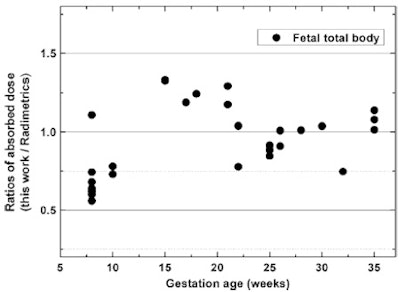 Ratios of absorbed doses to the fetal body between Monte Carlo calculations and Radimetrics dose-tracking system.
Ratios of absorbed doses to the fetal body between Monte Carlo calculations and Radimetrics dose-tracking system.The researchers discovered the absorbed dose is nonuniformly distributed between fetal organs. The fetal skeleton and bone marrow receive about 3.8 and 2.0 times higher absorbed doses than other fetal tissues.
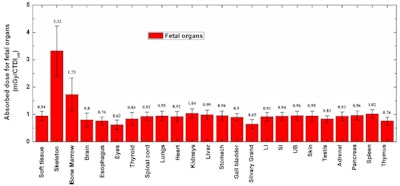

Normalized absorbed doses of fetal organs from CT scans performed on pregnant patients with the average values for each organ.
They also found no significant correlation between fetal total body dose and gestational age, while significant correlations were observed between fetal total body dose and the conceptus depth or maternal size. For the fetal brain, the correlation coefficients between absorbed dose and the gestational age, conceptus depth, and maternal size were -0.83, -0.71, and -0.58, respectively, indicating a significant correlation between fetal brain dose and those parameters.
The absorbed doses to some organs, such as the kidneys, gallbladder, large intestine, small intestine, and urinary bladder, presented insignificant correlations with both gestational age and conceptus depth, according to Xie and colleagues.
"Pregnant patients with a range of anatomical variability undergoing CT examinations can be adapted by segmenting CT images to produce a voxelized regional model and registering it to a standardized computational model to construct a patient-specific CT scan model suitable for incorporation in a dedicated Monte Carlo code," they wrote.
The researchers are also expanding the capabilities of the developed framework to other patient populations and different CT scanner models.




